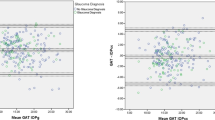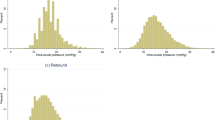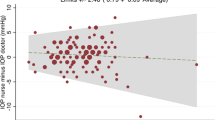Abstract
Aim
Assess current practice and views regarding checking Goldmann applanation tonometers for calibration errors in the United Kingdom.
Design
Questionnaire survey.
Methods
A total of 100 ophthalmology residents from England, Wales, and Scotland attending the 2004 Congress of the Royal College of Ophthalmologists, UK, responded to a structured questionnaire. They were asked the following: how often they used different tonometers between clinical sessions; how often they checked their tonometers for errors; and who they felt was responsible for checking tonometers for calibration errors.
Results
All respondents were using a different Goldmann tonometer for each clinic: 85% never check tonometers for errors; only 7% perform checks at the start of each clinical session; and 8% would only check the tonometer for calibration errors if they had suspicious or unexpected measurements. A total of 70% of respondents felt that calibration checks are not part of their responsibility. They believe that either nursing staff or other hospital staff should carry out calibration checks and ensure that tonometers are accurate. The remaining 30% felt that calibration checks should be carried out by the doctor using the tonometer.
Conclusion
Despite evidence that Goldmann tonometers lose accuracy during routine use in clinical practice, only a minority are checking the tonometers for calibration errors. There is no consensus as to who should be responsible for ensuring that tonometer calibration is maintained. We recommend that tonometers should be checked for calibration errors at least on a monthly basis by individuals identified by departmental protocols.
Similar content being viewed by others
Manuscript
Despite being invented more than 50 years ago, Goldmann applanation tonometer remains the gold standard for measurement of intra-ocular pressure (IOP). Recent studies suggest that Goldmann applanation tonometers are not as accurate as the manufacturer's recommended calibration error (CE) tolerance would suggest.1, 2, 3 In routine clinical practice, tonometers can quickly develop CE, and regular checks to maintain accuracy are necessary.1
Manufacturers suggest that CE should be in the range ±0.5 mmHg and any tonometer that does not meet this standard must be returned for calibration, as only the manufacturer can re-calibrate the tonometer.1, 4 However, there are no set guidelines or protocols on how often the CE checks should be made. Current literature suggests that annual checking is the normal practice.1, 2 Not only is the frequency of checks in question, but also whose responsibility it is to calibrate the tonometers has not been addressed. As patient management decisions are based on IOP measurements taken by the Goldmann tonometer, it is essential that accuracy of these instruments be assessed regularly.
A total of 100 ophthalmology residents from England, Scotland, and Wales, attending the 2004 Royal College of Ophthalmologists Congress, UK, were questioned about their current practice and views regarding tonometer calibration. They were asked the following: how often they used different tonometers between clinical sessions; how often they checked their tonometers for CE; and who they felt was responsible for checking tonometers for CE.
All respondents were using a different Goldmann tonometer for each clinic based on the clinics they were assigned to and the slit lamps they were using: 85% never check tonometers for CE; only 7% perform checks at the start of each clinical session; and 8% would only check the tonometer for calibration errors if they had suspicious or unexpected measurements.
A total of 70% of respondents felt that calibration checks are not part of their responsibility. They believe that either nursing staff or other hospital staff (eg medical physics department) should carry out calibration checks and ensure that tonometers are accurate. The remaining 30% felt that calibration checks should be carried out by the doctor using the tonometer.
IOP control is very important in the management of glaucoma.1, 5 Recently, the Early Manifest Glaucoma Trial showed that decreasing IOP by 1 mmHg leads to a 10% reduction in the risk of progressive nerve damage.5 Ideally, tonometers should be checked for CE each time they are used. Our findings suggest that despite using a different tonometer for every clinical session, only a minority were checking the tonometer for CE.
This is particularly significant as tonometers in busy clinics have been shown to lose accuracy within months after purchase or calibration by the manufacturer.1, 3 A recent study by Sandhu et al1showed that only 10% of tonometers fell within the manufacturer's recommended CE range. In addition, tonometers were found to be more likely to deviate into the positive range, overestimating IOP measurements.1
According to our survey, only a minority of respondents would check for CE if tonometer readings were suspicious or unexpected. This may imply that patient management is being based on IOP readings from an inaccurate tonometer. As tonometers with faulty calibration often overestimate the IOP, patients may be subjected to unnecessary medical or surgical intervention.
There was no consensus as to who should be responsible for ensuring that tonometer calibration is maintained. The annual calibration check during servicing of the slit lamp is now deemed inadequate. It is essential that all eye units develop protocols regarding calibration checks. An individual or a group of individuals should be clearly identified who will calibrate all departmental tonometers at regular intervals. When tonometer readings are suspicious, it is the responsibility of the doctor using the tonometer to ensure that the readings are not erroneous because of a CE. We recommend that tonometers should be checked for calibration errors at least on a monthly basis by individuals identified by each department who can be held responsible for ensuring tonometer accuracy.
References
Sandhu SS, Chattopadhyay S, Birch MK, Ray-Chaudhuri N . Frequency of Goldmann applanation tonometer calibration error checks. J Glaucoma 2005; 14(3): 215–218.
Wessels I, Oh Y . Tonometer utilisation, accuracy, and calibration under field conditions. Arch Ophthalmol 1990; 108: 1709–1712.
Whitacre M, Stein R . Sources of error with use of Goldmann-type tonometers. Surv Ophthalmol 1993; 38: 1–30.
Haag-Streit . Goldmann Applanation Tonometer Instruction Manual. 2003 Available at: www.haag-streit.com. Accessed on December 1, 2005.
Heijl A, Leske M, Bengtsson B, Hyman L, Hussein M, Early Manifest Glaucoma Trial Group. Reduction of intraocular pressure and glaucoma progression: results from the early manifest glaucoma trial. Arch Ophthalmol 2004; 120: 1268–1279.
Author information
Authors and Affiliations
Corresponding author
Additional information
The authors have no proprietary or financial interest in any of the products
Public and private financial support: nil
Rights and permissions
About this article
Cite this article
Kumar, N., Jivan, S. Goldmann applanation tonometer calibration error checks: current practice in the UK. Eye 21, 733–734 (2007). https://doi.org/10.1038/sj.eye.6702316
Received:
Accepted:
Published:
Issue Date:
DOI: https://doi.org/10.1038/sj.eye.6702316
Keywords
This article is cited by
-
Do ophthalmology residents know how to check the calibration of a Goldmann applanation tonometer?
International Ophthalmology (2023)
-
Potential effects of systematic errors in intraocular pressure measurements on screening for ocular hypertension
Eye (2013)
-
Goldmann tonometer calibration: a national survey
Eye (2009)



